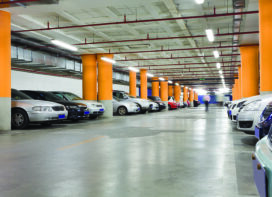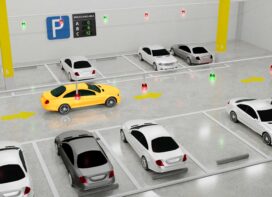Number of parking spaces

Pallet-based System
The number of spaces that can be achieved is affected depending on whether the parking structure is standalone or part of a larger building such as an office or residential tower.
In conventional parking structures, the floor area required per space is approximately 35 to 40 square meters. The floor to floor height in such structures is in the range of 3 to 3.5 metres. Thus, the volume occupied per parking space is 105 to 135 cubic metres.
However, in automated parking structures the floor area required per space is only 22 to 28 square metres while the floor to floor height is between 2 to 2.4 metres. Thus, the volume per space is in the range of 44 to 68 cubic metres. For the same building volume, an automated parking structure can thus accommodate more than twice the number of cars as compared to a conventional parking structure.
Land area and geometry

Non-pallet Solution
In conventional parking, the width of a typical double-loaded parking module is about 17 to 18 meters. Therefore, greatest efficiency is achieved if the land geometry allows multiples of this module. In addition, vertical circulation speed ramps as well as the external access ramps may take more than 25% of the land area and which needs to be considered in the design.
For certain types of automated parking systems, greater efficiency is achieved if the land geometry allows maximum number of tandem parking rows (usually 2 or 3) to be placed on either side of the central aisle. Typically, automated parking structures are more adaptable for irregular shaped land parcels when compared to conventional parking structures.
Number of entrances and exits
In conventional parking structures, number of entrances and exits are determined by traffic flow analysis including peak throughput volumes. Depending on the number of floors, entrances and exits may be required at different floors for better access and egress. For automated parking structures, number of gates are determined by the desired vehicle retrieval time and throughput requirements. In GCC countries, typical desirable vehicle retrieval time is 2 to 5 minutes during normal periods and 5 to 10 minutes for peak periods. Typical desired throughput time to empty the entire parking structure is 1 to 3 hours.
Safety and reliability
Safety and reliability is not a matter of primary concern in conventional parking structures due to inherent robustness of the structures and its components. However, in the case of automated parking structures. Redundancy of critical elements such as lifts, motors, control systems is essential. In addition, manual overrides of the main components are also needed in case of systems failure.
Cost
Generally, the most important factor which determines the selection of type of parking structure is the cost. The capital costs include both civil and equipment costs. Cost of land and the opportunity costs related to alternate land use are additional and may be significant.
Suitability of Automated Parking Structures in GCC contries
The proportion of conventional and automated parking structures varies greatly between different countries. In Japan, there are 60 to 90 million parking spaces. Five to 10 million spaces are in multi-story parking structures and out of which 1 to 1.6 million spaces are in automated parking structures. In other words, about 15 to 20% of the total multi-story parking spaces are in automated structures.
In Europe, out of 300 million parking spaces, there are about 50,000 multistory parking structures and 500 automated parking structures. Thus, automated parking constitutes only 1% of the total number of multi-story parking structures.
In the case of USA, there are 250 to 500 million parking spaces. Out of these there are about 45,000 multistory parking structures and less than 50 automated structures. Automated parking structures thus constitute only 0.1% of the number of multi-story parking structures.
As seen above, the percentage of automated parking structures is low compared to conventional structures in most of the countries.
There could be several reasons why automated structures have not become more accepted. One possible reason is that local architects and facility owners may not be fully aware of the capabilities of automated parking. There have been cases where the requirements of automated parking were not implemented in time during the planning phase of the project and subsequently required major adjustments at a later stage. The seriousness of these adjustments may have prevented its implementation.
Another reason for lower acceptance of automated structures is apprehension on the part of end users. Drivers are generally reluctant to use a new technology. There is a perception of lack of control of the vehicle after it is handed over to the automated system. From our observations, presence of full time attendants at the parking facility appear to ease these apprehensions. Facility owners also have apprehensions and concerns about operations and maintenance, retrieval times and reliability and more importantly about the costs.
Based on current trends, potential for additional automated parking structures exists in high-density, urban areas where land availability for parking is limited like Dubai, Abu Dhabi and other large GCC cities.
An increase in awareness and understanding of automated parking capabilities for end users and owners may alienate many of the existing concerns and apprehensions.
Future autonomous (self-driving) vehicles in GCC countries may have an impact on the future of parking needs, particularly in the dense part of cities. Committing large structures in these areas to parking facilities may be on the decline or at least may be questioned. Flexible design that allows today’s parking structures to be transferred to a different use may be in vogue.
 TrafficInfraTech Magazine Linking People Places & Progress
TrafficInfraTech Magazine Linking People Places & Progress


